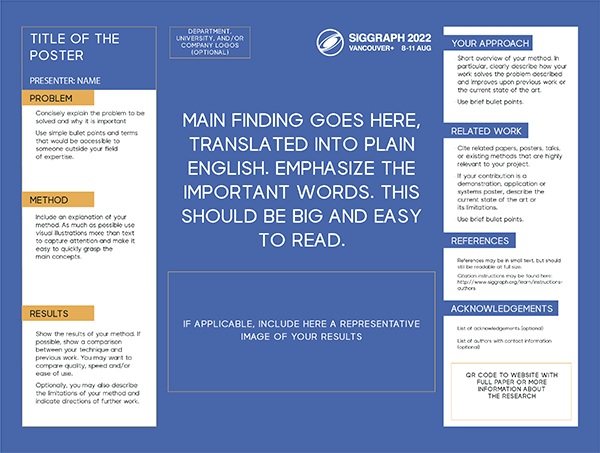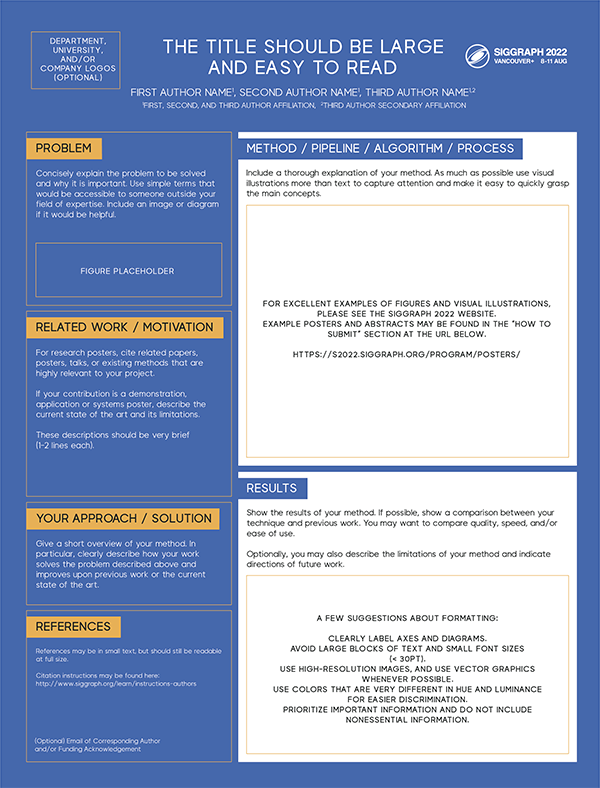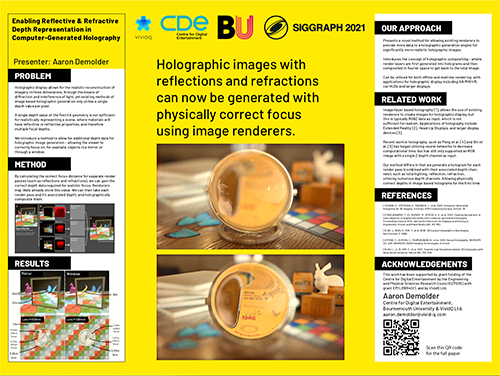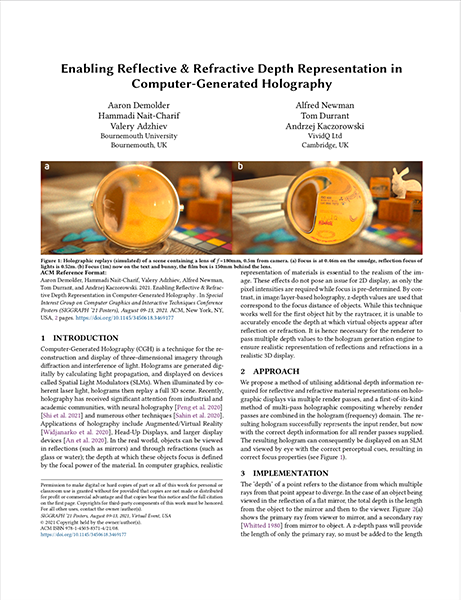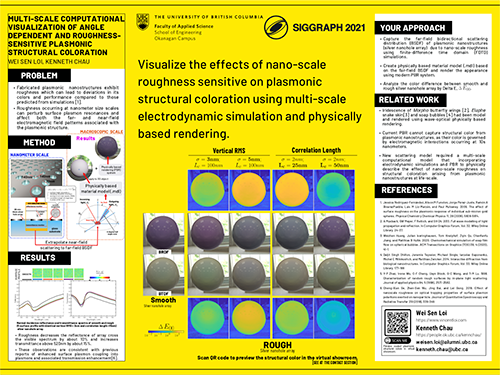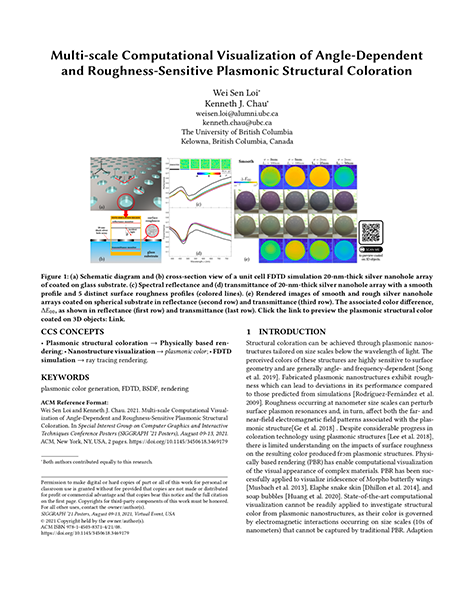Present New Perspectives
Posters
The SIGGRAPH Posters program is an interactive forum where students, researchers, artists, enthusiasts, and practitioners present the latest developments and ongoing research. Posters authors discuss their work, receive feedback, inspire and find inspiration from others, and network with researchers and industry professionals.
To explore SIGGRAPH 2022 content in detail, please review Posters’ listing on the ACM Digital Library.
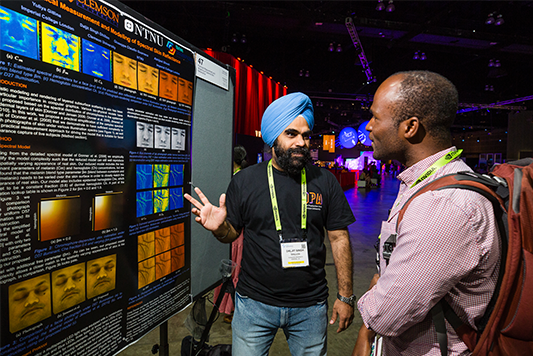
No matter the core concept, the ideal Posters submission expresses a novel and applicable idea in a simple, concise, visually appealing manner. There is no need to have a completely finished and polished product as long as the foundation of the work is strong and demonstrative results and initial findings are presented.
Accepted posters will be published in the ACM Digital Library.
Students also are encouraged to submit to the Student Research Competition for the chance to win a prize, be recognized, and progress to the ACM Student Research Competition Grand Finals!
Note: Submissions for Posters are currently closed.
How to Submit
SIGGRAPH 2022 will gather in person in Vancouver and virtually. We look forward to celebrating 49 years of advancements in computer graphics and interactive techniques and are excited you are submitting your work for consideration.
SIGGRAPH 2022 encourages Posters submissions that explore not only traditional topics in computer graphics and interactive techniques, but also exciting new topics and applications in the field. These include but are not limited to:
- Adaptability: New ways computer graphics and interactive techniques can help alternatively abled people in their day-to-day lives.
- Augmented and Virtual Reality: Innovations and interactive techniques in tomorrow’s virtual and augmented realities.
- Computer-Aided Design (CAD): Presentation of new ideas in CAD with practical applications to engineering, manufacturing, architectural rendering, and geometric design, among others.
- Film and TV Production: Ideas and applications in service of recent productions.
- Games: Techniques and technologies used in the development of technical and visual content for game production, game post-mortems, and other virtual world experiences.
- Human Experience: Health, home, and entertainment. The internet of things, the quantitative self, and immersive technologies have matured, and new data systems that support these innovations make way for more invention and interconnectedness.
- Mobile Devices: Innovations and interactive techniques in graphics applicable to the mobile space.
- Visualization: Developments that focus new approaches in computer-generated visual imagery and design in science, education, medicine, and visual analytics.
- Unique: Perhaps your work doesn’t fit a traditional computer graphics category — that’s great too!
Submission
Log into the submissions portal, select “Make a New Submission” tab, and then select the Posters submission form. To see the information you need to submit, view the Sample Submission Form.
In particular, please be aware of these fields:
- Poster Abstract: You are required to submit a poster abstract (two-pages maximum) describing the work that presented in your poster. Examples of poster abstracts can be found in the ACM Digital Library, in the Posters Sections of past SIGGRAPH Proceedings. See here for 2021.
- Submission Categories and Keywords: You will be asked to tag your submission with appropriate keywords to ensure your submission is appropriately reviewed and juried.
- Short Video: If your poster is accepted, you will be required to submit a short video (30 seconds) that showcases your work. Information on the formatting specifications of the video also will be provided with the acceptance notification. This video may be already submitted at the submission time.
- Poster: You may submit an initial version of your poster as part of your submission; however, you are not required to do so. The final poster only needs to be provided upon acceptance.
For guidance, we have provided both vertical and horizontal templates in Adobe Illustrator and PDF format, as well as some examples of recent SIGGRAPH abstracts and their corresponding posters. You are welcome to use these materials for general formatting suggestions. Note that your abstract also must conform to the ACM formatting guidelines using these templates and instructions. In any case, when planning your poster layout and content, we recommend that you avoid making it too dense and detailed. Bear in mind that during large poster sessions there is rarely enough time for attendees to read all of the information pertaining to the work described in a poster; posters should then maximize the amount of insight for attendees that may have only very little time to devote to a single poster. Your design should make it easy for a casual passer-by to extract the core message from a quick glance, and only provide detailed information on the side or as a weblink for interested parties. See Horizontal Poster Template for an example of applying these ideas.
Evaluation
Review Process
After your work is submitted, each poster will be assigned to a primary reviewer from the Posters Jury. The Posters Jury is a panel of experts chosen by the Posters Chair. In addition, each poster is assigned to some additional experts, the tertiary reviewers, selected either by the primary reviewer of that poster or by the Posters Chair. The Posters jurors and tertiary reviewers all write full reviews. Thus, each poster will be reviewed by multiple highly knowledgeable reviewers. After the reviews are completed, the Posters Jury meets to determine the final accept/reject decisions
Here are some of the criteria the reviewers use while evaluating each poster:
All submitters will have access to juror notes, which are provided as feedback and do not necessarily represent the reasons for the jury’s final decision.
Concept
How exceptional are the ideas, problems, solutions, aesthetics, etc., presented in this submission? How coherently does the submission convey its overall concept? Is the concept similar to existing ones, or does it stand out? This criterion is particularly applicable to submissions that put together existing technologies into a single product (e.g., demos, animations, art pieces). Submissions of this type, where the individual technologies are not necessarily new but their combination is, are evaluated on both the final product and how well proposed technologies integrate to meet the desired goals. Many submissions in this area are rejected because they do what existing systems do, and they do not demonstrate that the proposed approach leads to better results.
Novelty
How new and fresh is this work? Is it a new, ground-breaking approach to an old problem, or is it an existing approach with a slightly new twist? You must first demonstrate to the jury that your work is sufficiently different from existing approaches. Second, you should evaluate your work in the context of other approaches where appropriate: Is it faster? Easier to use? Does it give better results? Is it more accurate? Many submissions are rejected either because the work is too similar to existing work or because the submission materials did not convince the jury that the improvements were substantial enough.
Interest
Will conference attendees want to see this? Will it inspire them? Are the results or approach appealing to a broad audience? This is partly a measure of how broad the potential audience is and partly a measure of the overall clarity and novelty of the submission. A submission in a very niche area is more likely to be accepted if the results are exceptionally better than what exists already or if the proposed solution might be applicable to other areas.
Quality, Craft, and Completeness
This is a measure of how well-written the abstract is and the quality of the supporting materials. The abstract must effectively communicate both the problem and the solution in enough detail and clarity that the jury can evaluate it. You also must convince the jury that your solution works. You can do so through numerical results and/or an explanation of user tests. Many submissions are rejected because, while the problem and solution seemed interesting, the materials did not convince the jury that the solution had actually been implemented and evaluated. If your submission has an animation, simulation, or interactive component, then including a video is essential.
Upon Acceptance
Publication
You will be notified of acceptance or rejection of your poster in late May 2022 and receive an email from “rightsreview@acm.org” with information about and a link to your work’s rights form within 72 hours of notification of acceptance of your work to the conference. When your rights form has been delivered to ACM, you will then receive an email from “tapsadmin@aptaracorp.awsapps.com” with information about the preparation and delivery of your material to TAPS for publication.
Please make sure that emails from “rightsreview@acm.org” and “tapsadmin@aptaracorp.awsapps.com” are part of the “allow list” in your email program so that you do not miss these email messages.
The source (Word or LaTeX) of your abstract, as well as any supplemental materials, must be delivered to TAPS, ACM’s new article production system. TAPS will generate the PDF and HTML5 versions of your abstract for publication in the ACM Digital Library.
You must deliver your material to TAPS, resolve any formatting issues identified by TAPS or by the proceedings production editor, and approve your material for publication by 17 June 2022. If you cannot meet that deadline, you will not be allowed to present your material at SIGGRAPH 2022.
Information about the preparation and delivery of your final material to TAPS also can be found at https://homes.cs.washington.edu/~spencer/taps/taps.html.
In-Person and Virtual Presentation/Experience
If your work is accepted, you will need to:
- Update basic information about your work and upload any final materials for inclusion on the website. You need to finalize this information within the submissions portal by 9 June 2022. Be prepared to deliver the final versions of your work (camera ready) by this date, or your acceptance may be rescinded.
- Prepare and submit a poster describing your work. Contributors should only present accepted, jury-reviewed Posters content. Presenting new content is not allowed.
- Prepare and submit a revised two-page abstract (two-pages maximum). This abstract must be submitted to TAPS by 17 June 2022. Please prepare your abstract using these templates and instructions. If we do not receive your revised abstract and final poster PDF by 17 June, you will not be allowed to present at SIGGRAPH 2022.
- (Optional) Update your auxiliary images and video.
- Prepare a 30-second video in the style of a “fast forward” describing the work and its significance. This video must be submitted by 17 June 2022. Further details and instructions regarding the video specs will be provided upon acceptance. The fast forward videos for all posters will be combined into a single video presentation which will be available online to virtual conference participants and may also be displayed at a dedicated space during the in-person conference.
- Attend and present your work at SIGGRAPH 2022 in Vancouver, Canada. Posters presenters will be expected to participate in Posters sessions throughout the conference week.
As the conference approaches, you will receive more information about the Posters venue and presentation.
- You are responsible for bringing your poster and hanging it in the Vancouver Convention Centre by Sunday.
- Student Volunteers will be available in the Posters area to direct you to your poster board.
- You must be available to present your poster during the Posters presentation sessions. If you are unable to attend SIGGRAPH 2022, please contact the Posters Chair for assistance.
- In addition to the dedicated Posters sessions, select posters may be briefly presented during the Technical Papers (TP)/Art Papers (AP) Q&A sessions as part of the in-person conference experience. These posters will be selected after the Posters and AP/TP selection process and will be based on thematic similarities between the poster topics and the TP/AP session themes. Exact details will be provided upon acceptance.
- You must bring your poster to the conference. We cannot print it or accept shipments.
- We encourage you to bring a portable computer to demo your work. Outlets for power may not be available, so ensure your computer is well charged.
- Tables will be available in a limited quantity. The use of a table for your Posters presentation will be first-come, first-served, so please do not submit a poster that relies on table usage.
- Posters are displayed in unsecured areas; do not leave your computers or valuable equipment unattended.
If your poster is accepted, your poster’s two-page abstract, poster PDF, and final supplemental material — which can include the poster, video, and other material — will be available in the ACM Digital Library.
If you requested entry in the ACM Student Research Competition and your poster is accepted, it will be passed to the Student Research Competition jury for consideration. You will be contacted separately by the Student Research Competition Chair.
Presenter Recognition
To present your work at SIGGRAPH 2022, the contributor must be registered at the appropriate registration level for Posters.
You can find a link to the contributor recognition policy here.
ACM Rights Management Form
If your work is accepted for presentation at SIGGRAPH 2022, you must complete the ACM Rights Management Form. The form will be sent to all submitters whose work is accepted.
Your representative image and text may be used for promotional purposes. Several SIGGRAPH 2022 programs — Appy Hour, Art Gallery, Art Papers, Computer Animation Festival, Real-Time Live!, Technical Papers, and all installation programs — will prepare preview videos for pre-conference promotion of accepted content, which may include a portion of the video you submitted for review.
Timeline
26 April 2022, 22:00 UTC/GMT
Posters submission deadline (two-page abstract required).
Late May 2022
Acceptance and scheduling information or rejection notices are sent.
9 June 2022
Deadline for changes to materials for publication, including speakers, descriptions, abstracts, and images.
17 June 2022
PDF of final poster and two-page abstract submitted to TAPS. If we do not receive your revised abstract (submitted to TAPS) by 17 June, you may not be allowed to present at SIGGRAPH 2022.
30-second video due in Linklings.
24 July 2022
Official publication date.
8–11 August 2022
SIGGRAPH 2022
Poster Submissions FAQ
Should I submit a digital version of the actual poster for jury review?
No, this is not necessary. Posters submissions are evaluated based on their abstracts, supporting material, and research value. If you would like to provide a digital version of your poster, you may do so as a supplementary image.
Should my Posters abstract submission be author blind? Should I include line numbers?
No. Posters abstract submissions should include author name and affiliation, as well as the title of the work. You can prepare your Posters submission according to the ACM SIGGRAPH formatting instructions.
Can I include a supplementary video with my Posters submission?
Yes! If your submission has an interactive, animation, or simulation component, we strongly encourage you to submit a video demonstrating your work in action, as it is very difficult to evaluate your work without this.
The SIGGRAPH 2022 English Review Service failed our schedule, so it is SIGGRAPH’s fault that our proposal is late. Can I have an extension?
No. The English Review Service makes no guarantee for service turnaround. It also is administered separately from the conference program. Please schedule your work appropriately. For the best chance of having your submission reviewed by the English Review Service, please make sure it is submitted and marked “complete” in the submission system at least 14 days before your program’s submission deadline.
English Review Service Deadlines
Posters
11 April 2022
Do I get a discounted registration rate if my poster is accepted?
Yes! Once the contributor recognition policy becomes available, it will be linked here. Check back mid-January 2022.
What if more than one person from my team is planning to participate in the conference? Can all of us receive the discounted rate?
Unfortunately, we only are able to provide a discounted rate for one contributor per poster.

